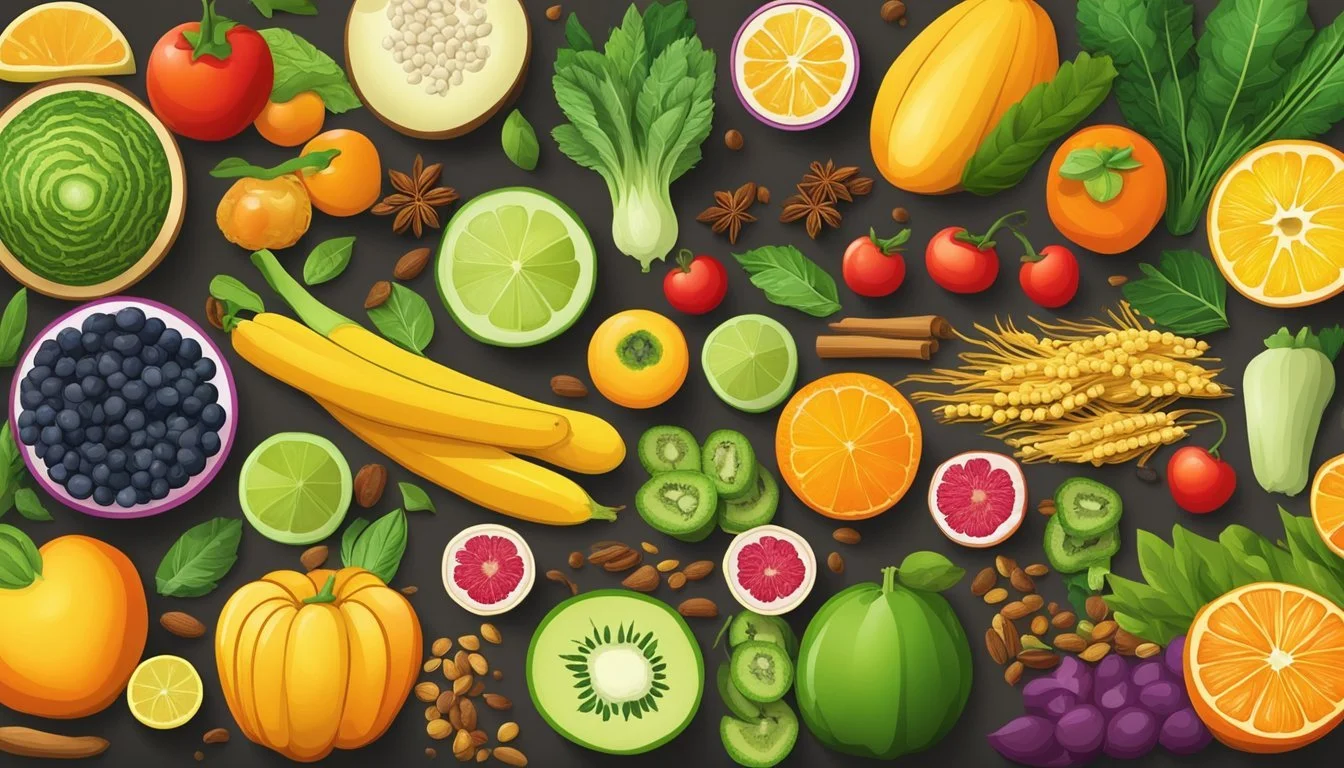How to Meal Prep for an Ayurvedic Diet
A Step-by-Step Guide
Embracing an Ayurvedic diet involves understanding the nutritional and energetic needs of one's body type according to Ayurvedic principles. Ayurveda, a traditional system of medicine from India, emphasizes balance in all aspects of life, including diet. According to Ayurveda, foods are categorized by their taste, energy, and post-digestive effect. Meal prepping in the Ayurvedic context requires a thoughtful approach to ensure that meals not only provide the necessary nutrients but also align with an individual's dosha—Vata, Pitta, or Kapha—to maintain or restore balance within the body.
Effective meal prepping for an Ayurvedic diet begins with planning. This entails identifying suitable fresh, whole foods that harmonize with one's dosha and preparing them in ways that make them easy to digest and nourishing. For those with a Kapha dosha, for example, meals would ideally be light, warm, and well-spiced. Incorporating routine into meal prepping can also contribute to a more balanced lifestyle, with set times for eating and engaging in mindfulness practices to enhance digestion and overall well-being.
Moreover, Ayurvedic meal prepping isn't merely about the food itself, but also about the process. It advocates for cooking with intention and preserving the life energy or 'prana' in foods, suggesting shorter meal prep periods to maintain freshness. Rather than prepping for a whole week, meal prepping for 2-3 days at a time can ensure that meals remain as beneficial as possible. In this way, an Ayurvedic approach to meal prepping goes beyond dietary requirements, fostering a connection between the food, the mind, and the digestive system.
Understanding Ayurveda and Diet
In Ayurveda, diet is a cornerstone to health, emphasizing the balance of three primary energy types known as doshas. It also focuses on nutrition and how it aids digestion, which is crucial to maintaining overall well-being.
Foundations of Ayurveda
Ayurveda, which translates to "science of life," is an ancient Indian system of medicine. It proposes that health is the balance of mind, body, and spirit. Central to Ayurveda is the concept that every individual is unique, with a distinct energy pattern made up of three fundamental doshas: Vata, Pitta, and Kapha. These doshas influence all biological, psychological, and physiopathological functions of the body and mind.
The Role of Doshas in Diet
Each dosha has characteristics that impact an individual's dietary needs. Vata, composed of air and ether, is linked to movement and flexibility, and its balance is maintained with warm, cooked foods that are easy to digest. Pitta, made of fire and water, governs metabolism and digestion, requiring cooling and energizing foods to temper its heat. Kapha, combining earth and water, provides structure and lubrication, balanced with light, dry, and warm foods to counter its inherent stability and heaviness.
Ayurvedic Perspective on Nutrition and Digestion
Ayurveda places great importance on agni, the digestive fire, key to converting food into energy. A balanced agni leads to the creation of ojas, which are vital essences that sustain life. Poor digestion can lead to the accumulation of ama, toxic byproducts that cause disease. Ayurvedic nutrition involves mindful eating practices, understanding the energetic qualities of food, and how they interact with the doshas. It encourages the inclusion of six tastes (sweet, sour, salty, bitter, pungent, astringent) in each meal to support balanced digestion and overall health, with an emphasis on fresh, whole foods and adequate prana, or life force.
Fundamentals of Meal Prepping
In adhering to an Ayurvedic diet, the approach to meal prepping is rooted in wellness and mindful nutrition, focusing on enhancing one's health through balanced meal planning and organization. Here's how individuals can adapt their meal prep practices in line with Ayurvedic principles.
Benefits of Meal Prepping
Meal prepping delivers several health advantages by aligning with the Ayurvedic focus on digestive fire and mindfulness. It enables an individual to maintain control over their nutritional intake, ensuring they consume freshly prepared, whole foods that cater to their unique doshic balance. Here's a quick overview:
Health Management: By having prepared meals, individuals can better manage their health by eating balanced portions with tailored nutrients.
Time Efficiency: Preparing meals in advance saves precious time throughout the week and simplifies decision-making.
Waste Reduction: Planned meals minimize food waste, as individuals buy only what they need.
Meal Planning Strategies
Effective meal planning is paramount in preserving the freshness and nutritional content advocated by Ayurveda. When strategizing:
Plan for 2-3 days at a time to ensure food freshness and vitality.
Incorporate a mix of cooked and raw foods while considering the best balance for one's dosha.
Focus on easy-to-digest, light, and warmning foods for Kapha, or cooling foods for Pitta, for example.
Day 1-3 Breakfast Lunch Dinner Dosha Type Balanced fruit porridge Seasonal veg stew Lightly spiced dal
Organizing Your Meal Prep Routine
To instill a sense of rhythm and attentiveness into meal preparation:
Allocate a Specific Time: Dedicate 1-2 hours every few days solely for meal prep to encourage consistency and mindfulness.
Store Food Properly: Use airtight containers to keep meals fresh, separating components if necessary.
Embrace Ritual: Treat meal prep as a calming, awareness-building practice, aligning with Ayurveda’s stress on being present.
By adopting these fundamentals of meal prepping within the framework of an Ayurvedic diet, individuals can create a harmonious balance between their nutrition, health, and overall wellness.
Ayurvedic Diet Principles
An Ayurvedic diet emphasizes the importance of balance and harmony within the body through the food one consumes. This section will explore the fundamental principles of meal prepping for an Ayurvedic diet, focusing on the six tastes, the balancing of doshas, and the foods to favor or limit.
Understanding the Six Tastes
Ayurveda identifies six tastes that are essential for creating a balanced diet:
Sweet – Promotes strength and nourishes all tissues
Sour – Stimulates appetite and aids digestion
Salty – Maintains mineral balance and aids in digestion
Bitter – Detoxifies and supports the liver and gallbladder
Pungent – Stimulates digestion and metabolism
Astringent – Absorbs water, tightens tissues, and dries fats
Each meal should include all these tastes to ensure proper digestion, absorption, and utilization of nutrients, while also supporting overall balance in the body.
Balancing the Doshas Through Diet
The three doshas – Vata, Pitta, and Kapha – are biological energies found throughout the human body and mind that govern all physical and mental processes. An Ayurvedic diet is personalized, aiming to balance these doshas, which vary among individuals. Foods are categorized according to the effect they have on each dosha:
Vata (air and space) – Requires warming, grounding foods to balance its cold, light, and dry qualities.
Pitta (fire and water) – Benefits from cooling, energizing foods to balance its hot, intense qualities.
Kapha (earth and water) – Needs light, stimulating foods to counterbalance its heavy, slow qualities.
Understanding one's predominant dosha and the current state of balance is crucial in selecting the right foods for meal prep.
Ayurvedic Foods to Include and Avoid
Individuals should focus on fresh, whole foods that are suitable for their dominant dosha. Here are some foods to include and others to generally avoid for each dosha type:
Vata:
Include: Warm, cooked foods, grains like rice and wheat, soft fruits, nuts, and dairy.
Avoid: Dry, cold foods and bitter, astringent fruits and vegetables.
Pitta:
Include: Cool or warm (not hot) foods, sweet fruits, vegetables, and dairy.
Avoid: Spicy, sour, salty foods (What wine goes well with salty foods?), and alcohol.
Kapha:
Include: Light, warm foods, dry grains like barley and corn, and honey.
Avoid: Sweet, sour, and salty foods, and fatty meats.
By incorporating these principles into meal prep, individuals can design a diet that supports their specific constitutional needs, promoting overall health and wellbeing.
Creating a Balanced Ayurvedic Meal
In an Ayurvedic diet, balance is achieved through careful attention to incorporating all six tastes and understanding portion sizes and food combinations that promote optimal digestion and health.
Incorporating the Six Tastes
Ayurveda identifies six tastes that should be included in each meal to create a harmonious balance:
Sweet: Foods like milk, grains, and certain fruits not only provide nourishment but also help to build tissues and calm nerves.
Sour: Ingredients such as lemon and fermented items stimulate the digestive fire.
Salty: Salt adds flavor and aids digestion, but should be used sparingly.
Bitter: Green leafy vegetables and herbs are examples of bitter foods (What wine goes well with bitter foods?) that offer detoxifying properties.
Pungent: Spices like ginger and cinnamon invigorate the digestion and cleanse the body.
Astringent: Legumes and certain raw fruits and vegetables offer a dry, cooling effect that is helpful in absorbing water and tightening tissues.
Each meal should include a mindful array of these tastes to support internal balance and nourishment.
Portion Sizes and Food Combinations
When planning an Ayurvedic meal, one has to consider not just the inclusion of the six tastes, but also the proper portion sizes and food combinations that can influence the digestive system. Here are guidelines to follow:
Grains should take up about 1/4th of the plate; they provide energy and satiety.
Protein sources, which can include legumes for vegetarians or vegans, should also occupy roughly 1/4th of the plate.
A variety of veggies representing different tastes should fill the remaining half of the plate to ensure an intake of essential nutrients.
It's important to combine foods that enhance each other's benefits and do not dampen the digestive fire. For example, cooking with a bit of ghee can aid in the absorption of nutrients and add a subtle richness to the meal. Foods should be prepared with love and care, as they are not only meant to feed the body but also to nourish the spirit.
Ayurvedic Cooking Techniques
Ayurvedic cooking techniques prioritize creating balance and catering to an individual's dosha. They involve the use of specific herbs and spices to enhance digestive fire, and can often include the use of a slow cooker for convenience and to preserve the nutritional values of the food.
How to Cook for Your Dosha
Individuals should first identify their dominant dosha—Vata, Pitta, or Kapha—to tailor their meal prep. For Vata types, warming and grounding foods are essential, often cooked with ghee and spices to aid digestion. Pitta types benefit from cooling and refreshing dishes with less heat-inducing spices. Kapha types should focus on light, warming foods that spark their slower digestive fire without overloading it.
For Vata:
Cooking medium: Ghee or sesame oil
Spices: Cumin, coriander, ginger
For Pitta:
Cooking medium: Coconut oil or ghee
Spices: Fennel, coriander, mint
For Kapha:
Cooking medium: Minimal oils, dry roasting preferred
Spices: Black pepper, turmeric, mustard seeds
Essential Ayurvedic Spices and Herbs
Herbs and spices are the cornerstone of Ayurvedic cooking, each with unique properties to balance doshas and promote digestion, or agni.
Turmeric: Aids in digestion; anti-inflammatory properties.
Cinnamon: Balances blood sugar; promotes digestion and circulation.
Cumin: Enhances digestive strength, assimilation of nutrients.
Coriander: Cooling spice, beneficial for Pitta and aids digestion.
These spices are commonly used in combinations that not only enhance the flavor of the dish but also contribute to holistic health.
Using a Slow Cooker in Ayurvedic Cuisine
A slow cooker aligns well with Ayurvedic principles, gently cooking the food in a manner that preserves prana and nutrients.
For Vata & Kapha: It can prepare nutritious, moist, and warm meals that are easy-to-digest.
For Pitta: It's suitable for preparing dishes at a lower temperature to avoid overheating.
Using a slow cooker is especially beneficial in Ayurvedic cuisine as it supports the gentle cooking at consistent temperatures, which is key to preserving the integrity of the wholesome ingredients used in this holistic culinary tradition.
Grocery Shopping and Food Storage
When preparing for an Ayurvedic diet, it is essential to focus on selecting high-quality, organic ingredients and storing them in ways that maintain their freshness and nutritional value. The goal is to maximize the life-giving energy, or prana, in your meals.
Selecting the Right Ingredients
Grocery Shopping: A visit to the grocery store for an Ayurvedic diet should prioritize organic fruits and vegetables, as these items are less likely to contain pesticides that can diminish their quality and prana. Seek out fresh, whole foods that align with Ayurvedic principles—warm, heavy, and moist for grounding; or light, dry, and cool for detoxifying.
Veggies: Opt for a variety of colors and types to balance the six Ayurvedic tastes. Vegetables are best when they are in season to ensure optimal freshness and potency.
Grains and Legumes: Choose whole grains and a range of legumes to provide a stable source of energy and nourishment. They should be free from signs of moisture to avoid spoilage.
Milk and Dairy Produkte: If dairy is included in the diet, fresh milk, butter, and ghee from high-quality sources are recommended to support digestive fire without increasing cholesterol unnecessarily.
Preserving Freshness and Potency
Fresh Meals: Preparing meals for only 2-3 days in advance helps to preserve the integrity and nutritional content of the food. This supports the concept of eating meals filled with prana rather than consuming cooked foods that have been stored for longer durations and have diminished vitality.
Herbs and Spices: Store them in airtight containers and in a cool, dark place to conserve their flavor and therapeutic qualities.
Fruits and Vegetables: Depending on their type, store either at room temperature or in the refrigerator crisper to maintain their crispness and quality.
Best Practices for Storing Prepared Meals
Cooked Foods Storage: Once the meals are prepared, they should be stored in clean, airtight containers. This ensures the food retains its quality and also extends its shelf life.
Temperature: Prepared meals must be stored at safe temperatures. Warm meals should be cooled to room temperature before refrigerating to prevent condensation which might lead to spoilage.
Organization: Labeling and arranging meals in the refrigerator based on their cooking date ensures that the oldest meals are consumed first, maintaining a cycle of freshness.
Timing and Frequency of Meals
When adopting an Ayurvedic diet, understanding the significance of meal timing and frequency is crucial for aligning with the body's natural rhythms, ensuring optimal digestion, and maintaining vitality.
Aligning Meals with the Circadian Rhythm
The concept of the circadian rhythm is fundamental to Ayurveda. It posits that one's physiology is closely linked to the natural cycles of day and night. To align meals with the circadian rhythm:
Breakfast should be consumed during the cooler, calm hours of the morning, which gently awakens the digestive fire, or agni.
Lunch, being the main meal of the day, is ideally eaten between noon and 2 PM when the sun is at its peak, and digestive agni is strongest.
Dinner should be lighter and completed before sunset to ensure food is digested before the body prepares for rest.
One's diet should include the six tastes—sweet, sour, salty, bitter, pungent, and astringent—in every meal, with sweet and sour tastes being particularly nourishing when eaten at appropriate times.
Determining the Size and Order of Meals
In an Ayurvedic diet, the size and order of meals are tailored to the individual's constitution and the strength of their digestion.
A substantial, nourishing breakfast that includes healthy fats and proteins supports sustained energy.
Lunch, being the largest meal, incorporates a balance of flavors to promote complete nutrition and to prevent imbalance in the doshas.
Dinner should be the smallest meal, with easily digestible foods that do not overload digestion before sleep.
Overall, Ayurveda emphasizes that regular meal times are essential for maintaining health, digestion, and vitality. It suggests eating three well-planned meals daily without snacking between them to allow the body to process food completely.
Special Considerations and Adaptations
When preparing meals with an Ayurvedic approach, it is crucial to consider varying individual needs and environmental factors. These considerations can significantly impact digestion, overall health, and alignment with Ayurvedic principles.
Adjusting Diet for Seasonal Changes
In Ayurveda, the seasons are closely linked with the elements—space, air, fire, water, and earth—and these can influence an individual's doshic constitution. For example, the summer heat increases the fire element within the body, so one should focus on cooling foods that are sweet, bitter, and astringent to balance the pitta dosha. This might include sweet fruits like melons, and plenty of cooked vegetables to support digestion. Conversely, in winter, when air and space elements are predominant, warming and grounding foods are recommended to stabilize vata.
Diet Variations for Different Life Stages
Ayurvedic wisdom emphasizes that dietary needs evolve with each stage of life. For instance, during the growth phase, children benefit from more sweet and sour foods to build tissues. Adults, especially when active and with a moderate lifestyle, may require a balanced mix prioritizing digestion and sustaining energy. Older adults should focus on mindful eating practices that prioritize digestion and limit hard-to-digest foods as digestion weakens with age.
Managing Dietary Restrictions and Preferences
Preferences and dietary restrictions, whether due to health, lifestyle, or ethical reasons, should be addressed mindfully. Individuals who, for instance, wish to pursue weight loss or have restrictions around caffeine, can adapt Ayurvedic meal prep to their needs while still adhering to the diet's core principles. For those with dietary restrictions, alternative ingredients can be incorporated to maintain balance. A restriction in consuming cold food items might mean favoring warm, cooked vegetables and grains, while those with a sensitivity to sugar can focus on bitter and astringent foods over sweet ones.
Common Challenges and Solutions
Transitioning to an Ayurvedic diet can pose unique challenges, yet thoughtful strategies can effectively address such difficulties. Here are solutions for dealing with cravings, digestive concerns, and following an Ayurvedic diet amidst non-Ayurvedic settings.
Dealing with Cravings and Emotional Eating
Individuals may struggle with cravings for foods not included in their Ayurvedic diet, often heightened by emotional stress. To conquer this, mindful eating practices can be influential. By focusing on the experience of eating and the flavors of food—particularly the six tastes (sweet, sour, salty, pungent, bitter, and astringent)—one can reduce emotional eating. The inclusion of lemon, for example, can fulfill the sour taste and aid in weight loss by promoting satiety. Moreover, cooking spices like turmeric and cumin can be added to satisfy various taste cravings while enhancing digestive fire.
Overcoming Digestive Issues with Ayurveda
Digestive issues such as gas, bloating, and constipation are common when adjusting to a new diet. In Ayurveda, it's necessary to maintain a strong agni or digestive fire. To aid digestion, incorporate Ayurvedic spices like ginger, black pepper, and fennel into meals, which can help stimulate digestion and alleviate discomfort. Additionally, opting for easily digestible foods such as kitchari—a simple dish of rice and lentils—ensures that nutrients are effectively absorbed without straining the digestive system.
Adapting to an Ayurvedic Diet in a Non-Ayurvedic Environment
Staying true to an Ayurvedic diet when surrounded by non-Ayurvedic options can be daunting. One should:
Plan Ahead: Prepare Ayurvedic meals like rice pudding for the sweet taste or spiced vegetables for the astringent taste, and bring them to social or work events.
Educate Others: Share the principles of Ayurveda, making it easier to maintain one's dietary choices in social settings.
Find Common Ground: Identify foods that are fundamentally Ayurvedic and commonly found in various cuisines, such as rice or herbal teas.
By employing these targeted solutions, adopting and maintaining an Ayurvedic diet, even amidst challenges, becomes more manageable.







